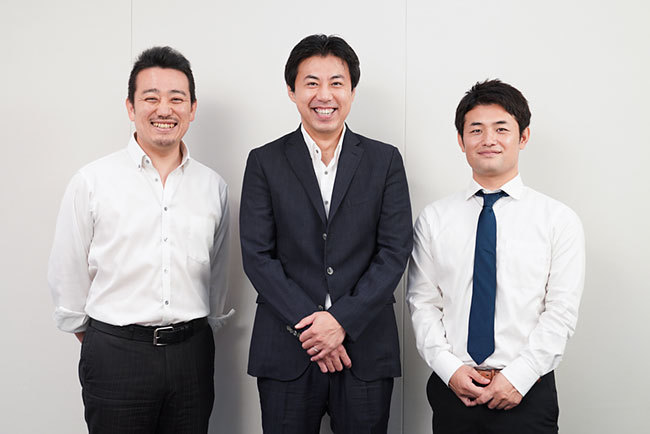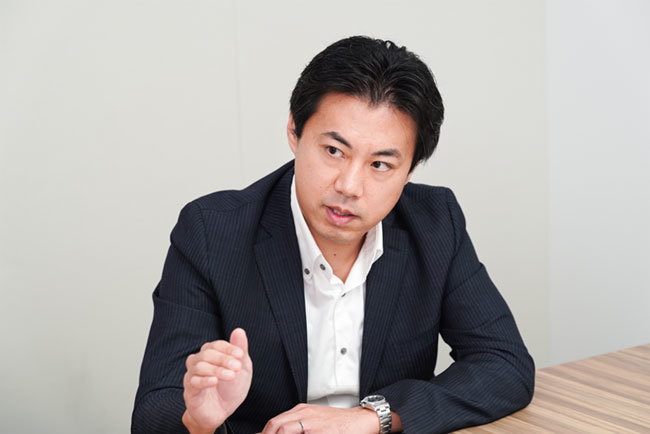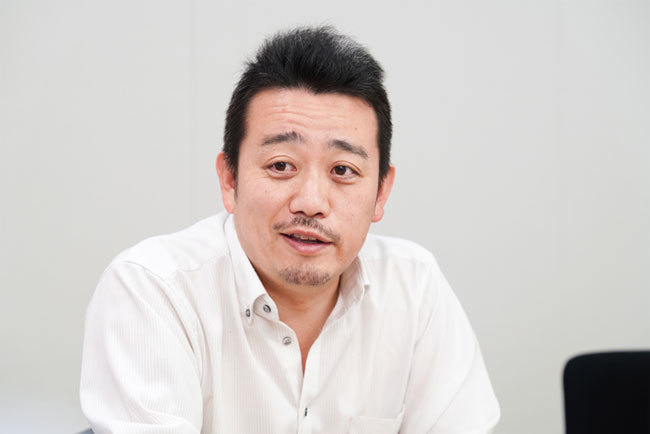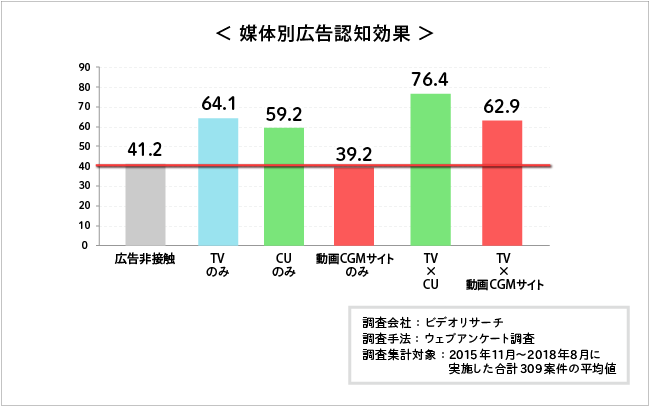
From left: Takafumi Ueki (Dentsu Inc. Media Services / Radio,TV Division), Hiroaki Sihara (TV Asahi), Ryota Murayama (Dentsu Digital Inc.)
Dentsu Inc., Dentsu Digital Inc., and Cyber Communications have launched "Premium View In-Stream Video Advertising" (hereinafter "Premium View"), a video advertising service that exclusively delivers ads to highly reliable and high-quality (i.e., premium) media and content, such as commercial broadcast catch-up services.
To convey the significance of this initiative, a roundtable discussion was held featuring Takafumi Ueki (Dentsu Inc. Media Services / Radio,TV Division) and Ryota Murayama (Dentsu Digital Inc.), who lead the "Premium View" project, along with Keiaki Sugihara from partner company TV Asahi. They discussed challenges facing digital video advertising and the benefits of delivering ads to commercial TV catch-up sites ( ).
Solving digital advertising problems and building a system beneficial to both advertisers and media companies

Mr. Hiroaki Sihara (TV Asahi)
Murayama: Today, we welcome Mr. Sugihara, the digital advertising manager at TV Asahi, to discuss the purpose and significance of "Premium View." Thank you for joining us.
Shibara: TV Asahi is also participating in "Premium View," providing advertising slots for catch-up services like "TV Asahi Catch Up" and "TVer" (which offer missed episodes and archived TV content). This marks the first time we're offering catch-up advertising slots in the programmatic space, and expectations are very high for "Premium View," which aims to create "premium advertising slots" in the digital realm.
Murayama: First, let me explain the background behind planning "Premium View."
Digital advertising faces various challenges. Recently, issues like "ad fraud"—where machines inflate click counts or video views—and compromised "brand safety" due to video ads appearing on inappropriate content like hate speech have become prominent. Advertisers are now strongly demanding solutions.
Additionally, publishers face their own problems, most urgently the collapse of digital ad prices. The rise of programmatic advertising has driven down CPMs, making it difficult for publishers to generate sufficient revenue and invest in rich content.
Ueki: While these issues have primarily been discussed in the banner ad world, the same challenges are now visible in the rapidly growing video ad space.
Digital advertising methods include "reservation-based," where fixed ad slots are purchased, and "programmatic," where prices and placements fluctuate in real time. The current market ratio is roughly 2:8. Having worked in television for so long, we naturally viewed reservation-based as the standard. However, we now recognize that programmatic holds greater demand and potential for video advertising too.
Murayama: Against this backdrop, we launched "Premium View" as a programmatic solution for delivering high-value, premium in-stream video ads. In-stream ads are the type that play during video content on sites like YouTube, similar to TV commercials.
"Premium View" consists solely of "premium inventory" like broadcast content, allowing advertisers to place ads on appropriate and safe content. It also enables publishers to sell ad slots at fair prices, using that revenue to create even better content. More quality content enriches the advertising environment and expands options for ad placements. Creating this ecosystem is our primary goal.
"High recognition effect" and "safe and secure environment" are Premium View's strengths

Takafumi Ueki (Dentsu Inc. Media Services / Radio,TV Division)
Murayama: When discussing this initiative, we need to consider the strengths of television as a medium, right?
Ueki: Terrestrial TV commercials possess overwhelming reach and recognition power. For example, a program with an average national network rating of 10% means approximately 6 to 10 million people are watching. No other medium offers such reach at once. Furthermore, research by the Dentsu Group and Video Research Ltd. has proven that television has a higher recognition effect than other media, meaning "people remember the ads."

Advertising recognition effectiveness: TV, catch-up, and video CGM sites. Units: %. The recognition effect is highest when combining TV and catch-up, followed by TV alone.
Sihara: One reason for this is that television has a large screen, creating a strong visual impact, which contributes to its recognition power.
Ueki: And the recognition power inherent in TV commercials is also carried over to catch-up viewing.
Since catch-up services don't allow ad skipping, the "complete view rate" (the percentage of viewers who start watching an ad and see it through to the end) is around 90%, significantly higher than other digital media.
Some worry that "not being able to skip ads" might give viewers a negative impression. However, a 2018 user survey by Dentsu Digital Inc. found that, in fact, it doesn't create a more negative image of the ads compared to platforms where in-stream ads can be skipped.
Murayama: That's surprising, isn't it? You'd think the inability to skip might cause stress and lead to negative impressions of the product or service.
Ueki: One possible reason is that platforms where ads can be skipped mix "skippable" and "non-skippable" ads.
Psychologically, if you can skip an ad even once on a given platform, you feel stressed when you can't skip it the next time. In contrast, catch-up services are designed so that ads cannot be skipped at all.
Sihara: Plus, "ads appearing between programs" is a long-standing habit and is accepted as natural in TV content, so catch-up viewers might feel less stress. Also, like TV, it has the characteristic of "viewers choosing content they want to watch and watching it attentively," which I think contributes to the ads' recognition effect.
Murayama: So, the concerns with in-stream video ads—like "Will they watch it all the way through?" or "Will it create a negative impression?"—are resolved with catch-up viewing. And ads are meaningless if they don't build awareness for products or services. Catch-up's overwhelming awareness power increases the "value per reach."
Mr. Sihara, where do you see the strengths of catch-up as an advertising medium?
Sihara: What we as the broadcaster want to emphasize most is, of course, "reliability." Catch-up delivers the same content as terrestrial broadcasts, and these programs are all produced following rules established at various levels—by the government, the National Association of Commercial Broadcasters in Japan (NACB), and individual broadcasters—and are also checked by third-party organizations.
Its greatest strength is undoubtedly the assurance of safe, secure, and high-quality content free from concerns like excessive hate speech, rights infringements, or fake information.
Murayama: Reliability is a huge point. Currently, most in-stream video ad placements are on user-generated media (CGM). User-generated content can include legally or ethically problematic material, and since checks are often automated, some issues slip through.
Ueki: Coming from someone with extensive experience in television, having content reliability guaranteed feels like a given, but the digital world is different.
Murayama: The "infinite reach" of programmatic advertising—the idea that ads can be delivered to "all kinds of content"—has caused many problems. "Premium View" doesn't blindly pursue infinite reach. We want advertisers seeking to run branding ads in a solid environment to know that, for the first time, programmatic in-stream video advertising now delivers what they need.
Sihara: One more thing to add: Catch-up viewing typically displays ads in full-screen mode, creative appeal is easily conveyed even on mobile devices, which is a major advantage.
We expect media platforms to connect and further enhance advertising effectiveness!
Ueki: Catch-up can essentially be considered the same awareness medium as TV commercials, but as a digital medium, it also offers the benefit of "easier visualization of attitude changes in users who saw the ad." Commercial catch-up includes Dentsu Inc.'s "People Tag," enabling data collection on site visits and product purchases after ad exposure.
Sihara: Marketing activities aren't self-contained within a single medium. Every advertiser considers "what actions to link together will ultimately benefit their company." They likely want to track viewers who saw the commercial all the way to conversion.
Even when delivering the same content, terrestrial broadcast and catch-up serve different advertiser objectives. Terrestrial broadcast can simultaneously appeal to many minds and shift societal attitudes. Catch-up, however, allows targeting specific audiences with tailored ads to drive further attitude change. Furthermore, if we can implement cross-platform strategies incorporating conversion-focused media, the value of catch-up as an advertising medium will increase significantly.
For example, TV Asahi also has AbemaTV, a platform with significant reach among younger demographics and light terrestrial TV users. We'd like to explore mechanisms that make it easier to purchase advertising slots in an integrated, cross-platform manner going forward. We hope that starting with "Premium View," the value of catch-up as an advertising medium will gain wider recognition.
Murayama: We won't limit ourselves to just "Premium View." The Dentsu Group has numerous schemes like STADIA, encompassing TV, online, and even OOH. We believe these will also satisfy advertisers. Thank you for today!










